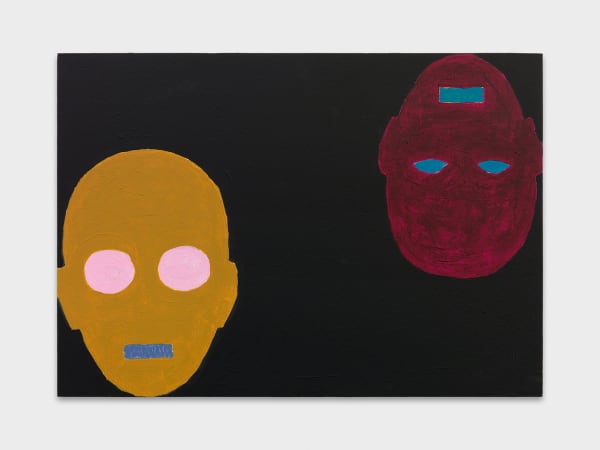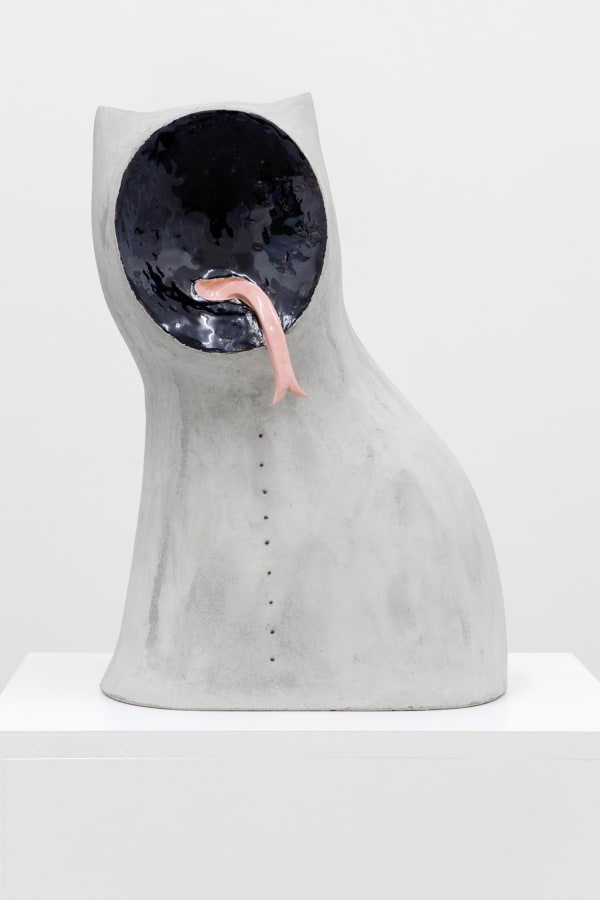If someone were to tell me that I have twenty years left to live and ask me how I would like to spend them, I would answer, “Give me two hours of activity a day, and I will spend the remaining twenty-two in dreams [...] assuming I can remember them.” I love dreams, even when they are nightmares, which is then what usually happens.
- Luis Buñuel
Opening date: September 6 September 6-8pm, exhibition runs until 1 October.
Courtesy to Hunt Kastner Gallery, Galerie Eva Presenhuber, Gallery Piktogram, Galeria Madragoa and Gallery Kraupa-Tuskany Zeidler.
Investigating the innermost ardors and fruitful impulses of existence has been the intent of Surrealist research since its inception. Despite the fact that the etymology of the word Surrealism suggests a beyond—something that lies beyond the real—the Surrealist parable accomplishes its course in terms of an emphasizing of the real itself. It pushes it to extremes, toward bitter and pulsating visions rooted in existence itself, only to return to it. The writings of French philosopher Maurice Merleau-Ponty come to mind. In his last compelling essay “The Eye and the Spirit” (1960) devoted to the work of the post-Impressionist painter Paul Cézanne, and, more generally, to modern art, Merleau-Ponty reaffirmed the need to return to intensely inhabiting things themselves, questioning that primordial gaze they directed beyond the places illuminated by the soothing light of reason. Such a conception constitutes one of the loftiest reflections on the question of the fate of painting within a world imbued, already ab illo tempore, with science, which is becoming more and more pressing, and its sterile abstractions, dangerously predisposed to irrevocably burying its own original foundation.
And it is according to such precepts that we arrive at the free, twisted, provocative, and acute visions of the American painter, poet, writer, and insatiable experimentalist Dorothea Tanning (Galesburg, Aug. 25, 1910-New York, Jan. 31, 2012).
Between reality and sensation, object and subject, life is hand, chest, corporeality and flesh. This double, this two-fold operation of reaffirming reality, is what Tanning has accomplished through her art, pushing the frontiers of surrealism to the extreme and manifesting what doubly bleeds of existence, human feeling. She concretely reveals what is the pre-objective layer of experience that inhabits our bodies and gives meaning to existence. through his exploratory brushstrokes, a very personal view of the world in all its colorful intensity. Her artistic experience is an ode to continuous research and the ability to transform, which has no limits: “a true artist must explore all the means at his disposal as long as he breathes,” these were her words. Further, Tanning added that “it would be grotesque to paint the same way all your life. It is a form of hibernation.” With a rather tranchy geniality, she often seeks to lay bare the that which is not permitted with an edgy and impertinent irony that dismembers and analyzes everything that comes before her, without ever retreating because, as the Surrealist Max Ernst (with whom, by the way, Tanning had a passionate love affair that lasted some thirty-four years) argued, “you can drink the images with your eyes," without necessarily having to be afraid of them.
And this is how this exhibition “Tanning's touch,” dedicated to Tanning herself, was conceived. The exhibition’s title takes inspiration from Lettre d'Amour (“Love Letter”), one of the masterpieces created by Tanning in 1948, a work featured in the exhibition and studded with other artworks brilliantly crafted by the six different artists invited freely interpret the aforementioned masterpiece: Valentin Carron, Ani Gurashvili, Anna Hulačová, Iwo Panasiewicz, Jaime Welsh, Guan Xiao.
In his sculptures and collages, Valentin Carron imitates traditional handicrafts and unknown artworks, as well as stereotypical modern and everyday forms. By appropriating these objects and styles, he questions originality, authenticity, and identity in the globalized world. He reformulates traditional handicrafts, mainly from his Swiss homeland, by substituting natural materials like wood for synthetic materials; conversely, he commissions well-trained craftsmen to create precious works imitating cheap industrial articles.
Ani Gurashvili states that her “works explore the narrative potential of painting as well as the convention of representation by creating semi-identifiable spaces, shifting perspectives, and focusing on new unexpected angles.” Her paintings are built on contradictory strategies and effects (switches): finding and hiding; locking and unlocking; zooming in and zooming out; inspecting inside and outside, and, sometimes, in-between. Her paintings often aspire to create the effect of a reflection in an obsidian mirror in which light is powerful enough to glow and illuminate dark surfaces. To follow this light allows the discovery of new shapes and new spaces. She is fascinated by humanity’s tireless attempts throughout history to communicate with the supernatural and to self-empower through magical thinking. Her interest is rooted in speculative fiction—mainly feminist science fiction—female surrealist painting, as well as anime, and role-playing game aesthetics. She states “I consider these references as tools, and like to mix them in a syncretic and sometimes opulent visual language, to build otherworldly and yet familiar multilayered spaces. My works are neither narrative nor illustrative, they are merely a grouping of idiosyncratic symbols that gather together in the process of painting.”
Anna Hulačová (born 1984, Sušice, ČSSR) studied at the Academy of Fine Arts in Prague. She is an extraordinary sculptor, whose work revives traditional crafts, translating the inspiration found in ancient mythologies, eastern cultures, as well as in Czech folk traditions, and original Christian symbolism into the language of contemporary art. In her approach to art, Hulačová has always broken down hierarchies. She uses the subjects and materials traditionally associated with fine art in combination with that of applied and folk art across cultures and these in combination with contemporary media and aesthetics. Her choice of material does not privilege the hardy over the ephemeral and she works with cement and wood but equally with putty, dough, straw or beeswax.
In his artistic practice Iwo Panasiewicz limits himself to working with pencil and colored pencil on small-format paper. Through this kind of gesture he builds an intimate atmosphere that corresponds to the body of my works—a focus on inner experiences, an analysis and an attempt to present them in the form of an image. He filters his experiences and emotions, then tries to extract from them a certain synthesis and essence, which materializes in the form of a drawing. In his works, he attempts to build metaphorical scenes and micro-narratives using signs and symbols, the final decoding of which is up to the viewer. He trusts in the intuition and sensitivity of the audience and his ability to build nonverbal messages.
Since 2017 Jaime Welsh has been developing a photographic practice that is often in dialog with the history of European architecture, film, and queer culture. In 2021 he graduated from the MFA fine art at Goldsmiths where he produced a body of work which included meticulously constructed photographs shot within Portuguese official institutions and governmental organizations. Through implementing a particular use of architectural form and set design, he builds atmospheres of psychological tension, doubt, and alienation. Glass windows and mirrors are often included in the space of my photographs, these operate as portals of subconscious escape while redirecting attention into the medium of photography itself. “Throughout my adobe Photoshop editing process, the friends I photograph slowly mutate into proxy characters. I swap, double and shatter their identities; their appearance is twisted and sometimes I decapitate them,” states the artist. Ultimately, his photographs produce these bodies rather than depict them. Through photographing those close to him, the photographs also function as love infatuations. He has an obsessive desire in understanding the corporality of the very particular types of bodies, clothes, furniture, and architecture that he photographs. “Through exposing a very detailed and tangible sense of their materiality, I am reclaiming and repurposing the fetishistic gaze,” says Welsh. His photographs trigger a story-line response, yet they are just compositions of props that he has set up to confound narrative expectations. The development of events is always uncertain. There is no correct before or after, only a lack, to be imaginatively filled in the viewers’ mind. He explores the relationships between architectural and psychological interiority, questioning the many levels by which architectural form shapes our identity and sense of belonging. Moreover, the photographs investigate the ways by which the bodies contained within them activate, transgress, and reconfigure these spaces.
Guan Xiao(b. 1983) lives and works in Beijing. Her practice focuses primarily on sculpture, video, and installation. Combining a wide array of visual references, Guan Xiao continuously reinvents her biographical details such as identity, personal history, geographical background and the experience of her daily life by inscribing them into her exuberant works. Guan Xiao takes her sculpture and installations as virtual characters or “species” which she imbues with a new, literalized identity. The artist attempts to emphasize the importance of difference by creating purposeful contradictions between the materiality and the concept. Her works generate cohesive textures between binaries sourced from contrasting and even conflicting worlds, and fuse old and modern, digital and analogue, and natural and artificial modes. Attuned to both possibilities and looming hazards, Guan Xiao’s prescient and puzzling arrangements critique the technological thrust of the present moment while providing indelible visions of our dislocated, rapidly approaching future.
-
 Ani Gurashvili, The onyx curtain, 2022
Ani Gurashvili, The onyx curtain, 2022 -
 Jaime Welsh, The Ambassadors Suite (revisited, 2022
Jaime Welsh, The Ambassadors Suite (revisited, 2022 -
 Guan Xiao, A Sinking Blue Field, 2019
Guan Xiao, A Sinking Blue Field, 2019 -
 Valentin Carron, Ovals In The Dark I, 2021
Valentin Carron, Ovals In The Dark I, 2021










